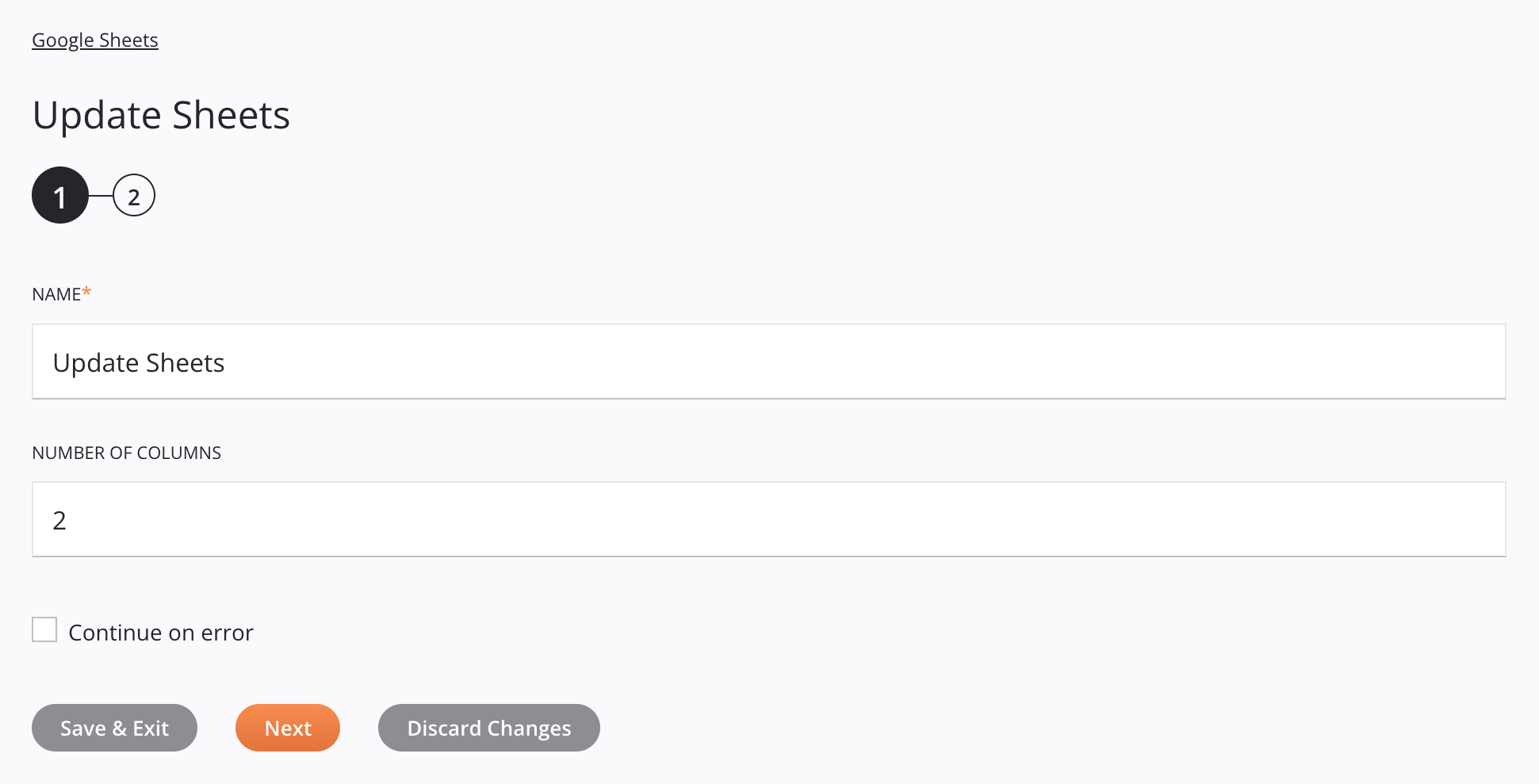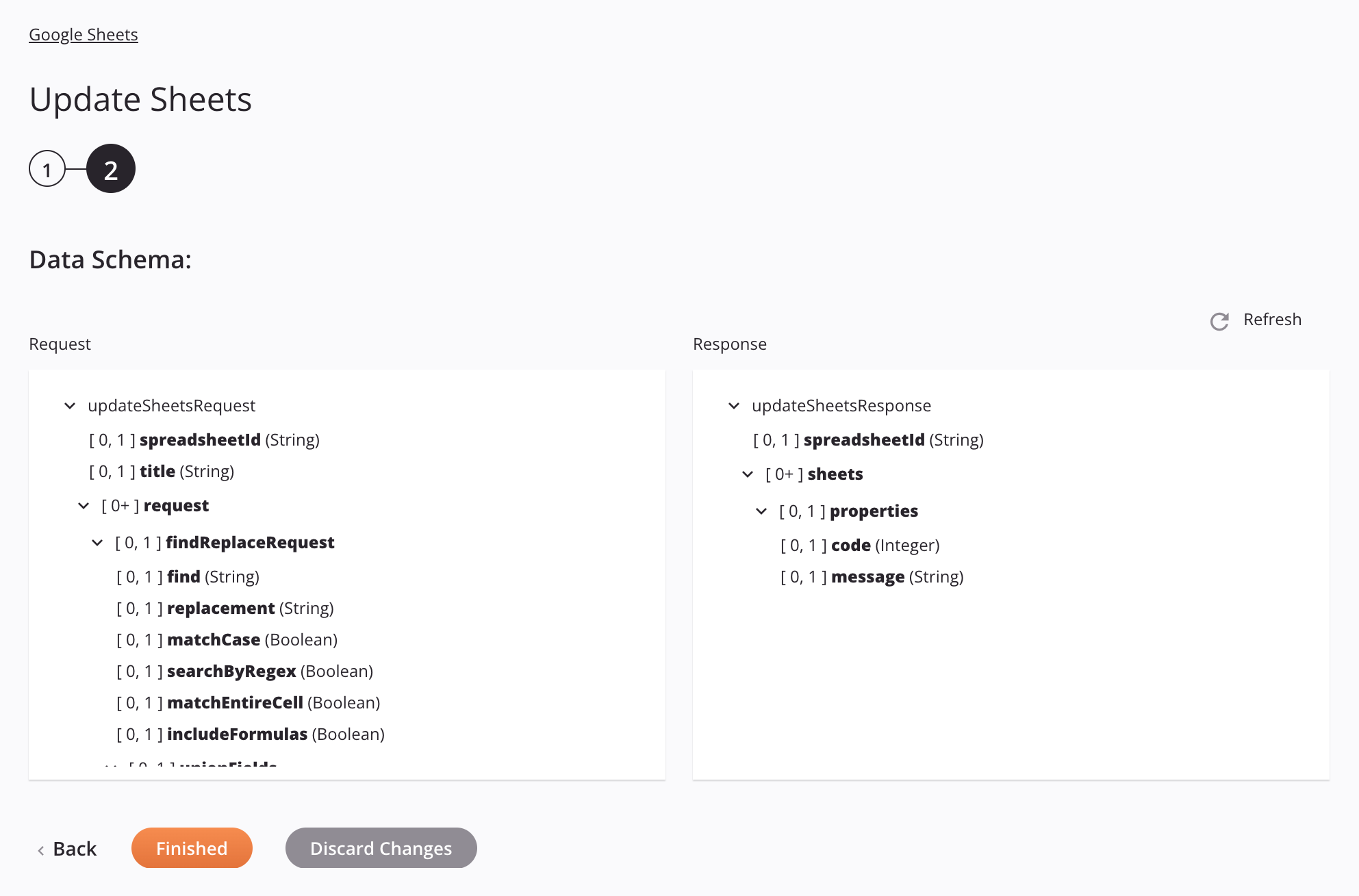Google Sheets Update Sheets activity¶
Introduction¶
A Google Sheets Update Sheets activity, using its Google Sheets connection, updates a Google Sheets spreadsheet and is intended to be used as a target to consume data in an operation.
Create a Google Sheets Update Sheets activity¶
An instance of a Google Sheets Update Sheets activity is created from a Google Sheets connection using its Update Sheets activity type.
To create an instance of an activity, drag the activity type to the design canvas or copy the activity type and paste it on the design canvas. For details, see Create an activity instance in Component reuse.
An existing Google Sheets Update Sheets activity can be edited from these locations:
- The design canvas (see Component actions menu in Design canvas).
- The project pane's Components tab (see Component actions menu in Project pane Components tab).
Configure a Google Sheets Update Sheets activity¶
Follow these steps to configure a Google Sheets Update Sheets activity:
-
Step 1: Enter a name and specify settings
Provide a name for the activity and specify the number of columns. -
Step 2: Review the data schemas
Any request or response schemas are displayed.
Step 1: Enter a name and specify settings¶
In this step, provide a name for the activity and specify the number of columns. Each user interface element of this step is described below.

-
Name: Enter a name to identify the activity. The name must be unique for each Google Sheets Update Sheets activity and must not contain forward slashes
/or colons:. -
Number of Columns: Enter the number of columns to be used when creating the spreadsheet (optional); if not provided, the default value of 26 is used.
-
Continue on Error: Select to continue the activity execution if an error is encountered for a dataset in a batch request. If any errors are encountered, they are written to the operation log.
-
Save & Exit: If enabled, click to save the configuration for this step and close the activity configuration.
-
Next: Click to temporarily store the configuration for this step and continue to the next step. The configuration will not be saved until you click the Finished button on the last step.
-
Discard Changes: After making changes, click to close the configuration without saving changes made to any step. A message asks you to confirm that you want to discard changes.
Step 2: Review the data schemas¶
Any request or response schemas are displayed. Each user interface element of this step is described below.

-
Data Schemas: These data schemas are inherited by adjacent transformations and are displayed again during transformation mapping.
Note
Data supplied in a transformation takes precedence over the activity configuration.
The Google Sheets connector uses the Google Sheets API v4. Refer to the API documentation for information on the schema nodes and fields.
Important
While the cardinality of the
spreadsheetId,title, andsheetIdfields is[0, 1]in the request schema (indicating the fields as optional), input for these fields is required by the Google Sheets API, as documented below.-
Request:
Request Schema Field/Node Google API Field/Method, type Notes updateSheetsRequestspreadsheets.updateRequest to update a spreadsheet spreadsheetId(required)spreadsheetIdID of the spreadsheet to be updated (required) title(required)titleSheet title (required) requestnode Each request is one of findReplaceRequest,addSheetRequest,updateSheetRequest,deleteSheetRequest,deleteCellRequest, orupdateCellRequestfindReplaceRequestFindReplaceRequestFinds and replaces data in cells over a range, sheet, or all sheets findString The value to search replacementString The value to use as the replacement matchCaseBoolean Trueif the search is case sensitivesearchByRegexBoolean Trueif the find value is a regex. The regular expression and replacement should follow Java regex rules.matchEntireCellBoolean Trueif the find value should match the entire cellincludeFormulasBoolean Trueif the search should include cells with formulas. False to skip cells with formulas.unionFieldsnode Union field scope: The scope over which to find/replace; you must set one of the SheetIDorallSheetsfields or the fields under the[gridRange][grid-range]node.addSheetRequestupdateSheetsRequestspreadsheets.updateRequest to update a spreadsheet spreadsheetIdspreadsheetIdID of the spreadsheet to be updated titletitleSheet title requestnode Each request is one of findReplaceRequest,addSheetRequest,updateSheetRequest,deleteSheetRequest,deleteCellRequest, orupdateCellRequestfindReplaceRequestFindReplaceRequestFinds and replaces data in cells over a range, sheet, or all sheets findString The value to search replacementString The value to use as the replacement matchCaseBoolean Trueif the search is case sensitivesearchByRegexBoolean Trueif the find value is a regex. The regular expression and replacement should follow Java regex rules.matchEntireCellBoolean Trueif the find value should match the entire cellincludeFormulasBoolean Trueif the search should include cells with formulas. False to skip cells with formulas.unionFields(required)node Union field scope: The scope over which to find/replace; input in either the SheetIDorallSheetsfield is requiredSheetIdInteger The sheet to find/replace over allSheetsBoolean Set to trueto find/replace over all sheetsgridRangenode Finds and replaces data within a range on a sheet sheetId(required)Integer The sheet this range is on (required) startRowIndexInteger The start row (inclusive) of the range endRowIndexInteger The end row (exclusive) of the range startColumnIndexInteger The start column (inclusive) of the range endColumnIndexInteger The end column (exclusive) of the range -
Response:
Response Schema Field/Node Google API Field Notes updateSheetsResponsen/a Response from creating the spreadsheet spreadsheetIdspreadsheetIdID of the newly-updated spreadsheet sheetsn/a Node representing the spreadsheet propertiesn/a Node representing the properties returned coden/a Error code returned (if any) messagen/a Message returned upon creation (if any)
-
-
Refresh: Click the refresh icon
 or the word Refresh to regenerate schemas from the Google Sheets endpoint. This action also regenerates a schema in other locations throughout the project where the same schema is referenced, such as in an adjacent transformation.
or the word Refresh to regenerate schemas from the Google Sheets endpoint. This action also regenerates a schema in other locations throughout the project where the same schema is referenced, such as in an adjacent transformation. -
Back: Click to temporarily store the configuration for this step and return to the previous step.
-
Finished: Click to save the configuration for all steps and close the activity configuration.
-
Discard Changes: After making changes, click to close the configuration without saving changes made to any step. A message asks you to confirm that you want to discard changes.
Next steps¶
After configuring a Google Sheets Update Sheets activity, complete the configuration of the operation by adding and configuring other activities, transformations, or scripts as operation steps. You can also configure the operation settings, which include the ability to chain operations together that are in the same or different workflows.
Menu actions for an activity are accessible from the project pane and the design canvas. For details, see Activity actions menu in Connector basics.
Google Sheets Update Sheets activities can be used as a target with these operation patterns:
- Transformation pattern
- Two-transformation pattern (as the first or second target)
To use the activity with scripting functions, write the data to a temporary location and then use that temporary location in the scripting function.
When ready, deploy and run the operation and validate behavior by checking the operation logs.